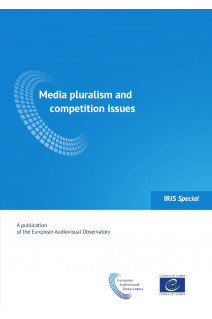1. Introduction 2. How to define media pluralism?
2.1. Concentration dimensions in the digital transformation
2.2. An approach based on competition law: Quantity and market power
2.3. A fundamental rights-based approach: Quality und “public value”
3. Media pluralism from an economic perspective: Algorithmic media – new considerations for media plurality
3.1. Introduction: Expanding debates on media pluralism
3.2. Computation: From mediation to the production of media outcomes
3.3. Mediatisation, datafication, algorithmisation
3.3.1. Mediatisation
3.3.2. Datafication
3.3.3. Algorithmisation
3.4. From interface to infrastructure: Multi-level media pluralism
3.5. Pluralism in algorithmic media – learnings from digital advertising
3.6. Implications for policymakers and academics
4. Media pluralism from a legal perspective
4.1. European and national law on media mergers and media concentration
4.2. Possibilities of promoting media diversity under EU state aid law
4.3. Reference points for the promotion or protection of diversity in existing and future EU law
4.3.1. European Electronic Communications Code
4.3.2. Audiovisual Media Services Directive
4.3.3. The P2B Regulation
4.3.4. Copyright in the Digital Single Market Directive
4.3.5. Regulation of data processing operations
5. Country reports
5.1. BE - Belgium
5.1.1. Introduction
5.1.2. Control mechanisms under national (media) concentration law
5.1.3. (Recent) Decisions of national competition and antitrust authorities regarding media providers or intermediaries/platforms
5.1.4. Relationship between public service and private/commercial
5.1.5. Transposition of pluralism-related EU provisions
5.1.6. Funding mechanisms to ensure media diversity
5.2. DE -Germany
5.2.1. Introduction
5.2.2. Control mechanisms under national (media) concentration law
5.2.3. (Recent) Decisions of national competition and antitrust authorities regarding media providers or intermediaries/platforms
5.2.4. Relationship between public service and private/commercial media
5.2.5. Transposition of pluralism-related EU provisions
5.2.6. Funding mechanisms to ensure media diversity
5.2.7. Other developments regarding media pluralism on the national level
5.3. GB - United Kingdom
5.3.1. Introduction
5.3.2. Control mechanisms under national (media) concentration law
5.3.3. (Recent) Decisions of national competition and antitrust authorities regarding media providers or intermediaries/platforms
5.3.4. Relationship between public services and private/commercial media
5.3.5. Transposition of pluralism-related EU provisions
5.3.6. Funding mechanisms to ensure media diversity
5.3.7. Other developments regarding media plurality on the national level
5.4. IT - Italy
5.4.1. Introduction
5.4.2. Control mechanisms under national (media) concentration
5.4.3. (Recent) Decisions of national competition and antitrust authorities regarding media providers or intermediaries/platforms
5.4.4. Relationship between public service and private/commercial media
5.4.5. Transposition of pluralism-related EU provisions
5.4.6. Funding mechanisms to ensure media diversity
5.4.7. Other developments regarding media pluralism on the national level
5.5. LV - Latvia
5.5.1. Introduction
5.5.2. Control mechanisms under national (media) concentration law
5.5.3. (Recent) Decisions of national competition and anti-trust authorities regarding media providers or intermediaries/platforms
5.5.4. Relationship between public service and private/commercial media
5.5.5. Transposition of pluralism-related EU provisions
5.5.6. Funding mechanisms to ensure media diversity
5.6. PL - Poland
5.6.1. Introduction
5.6.2. Control mechanisms under national (media) concentration law
5.6.3. (Recent) Decisions of national competition and antitrust authorities regarding media providers or intermediaries/platforms
5.6.4. Relationship between public service and private/commercial media
5.6.5. Transposition of pluralism-related EU provisions
5.6.6. Funding mechanisms to ensure media diversity
5.6.7. Other developments regarding media pluralism on the national level
5.7. SE - Sweden
5.7.1. Introduction
5.7.2. Control mechanisms under national (media) concentration law
5.7.3. (Recent) Decisions of national competition and antitrust authorities regarding media providers or intermediaries/platforms
5.7.4. Relationship between public service and private/commercial media
5.7.5. Transposition of pluralism-related EU provisions
5.7.6. Funding mechanisms to ensure media diversity
5.7.7. Other developments regarding media plurality on the national level
5.8. SI - Slovenia
5.8.1. Introduction
5.8.2. Control mechanisms under national (media) concentration law
5.8.3. (Recent) Decisions of national competition and antitrust authorities regarding media providers or intermediaries/platforms
5.8.4. Relationship between public service and private/commercial media
5.8.5. Transposition of pluralism-related EU provisions
5.8.6. Funding mechanisms to ensure media diversity
5.8.7. Other developments regarding media plurality on the national level
6. Comparative analysis 7. Conclusions FiguresFigure 1. Digital advertising spend by transaction mechanism
Figure 2. Digital advertising spend by transaction mechanism
Figure 3. Interface and infrastructure
Figure 4. Programmatic supply chains




